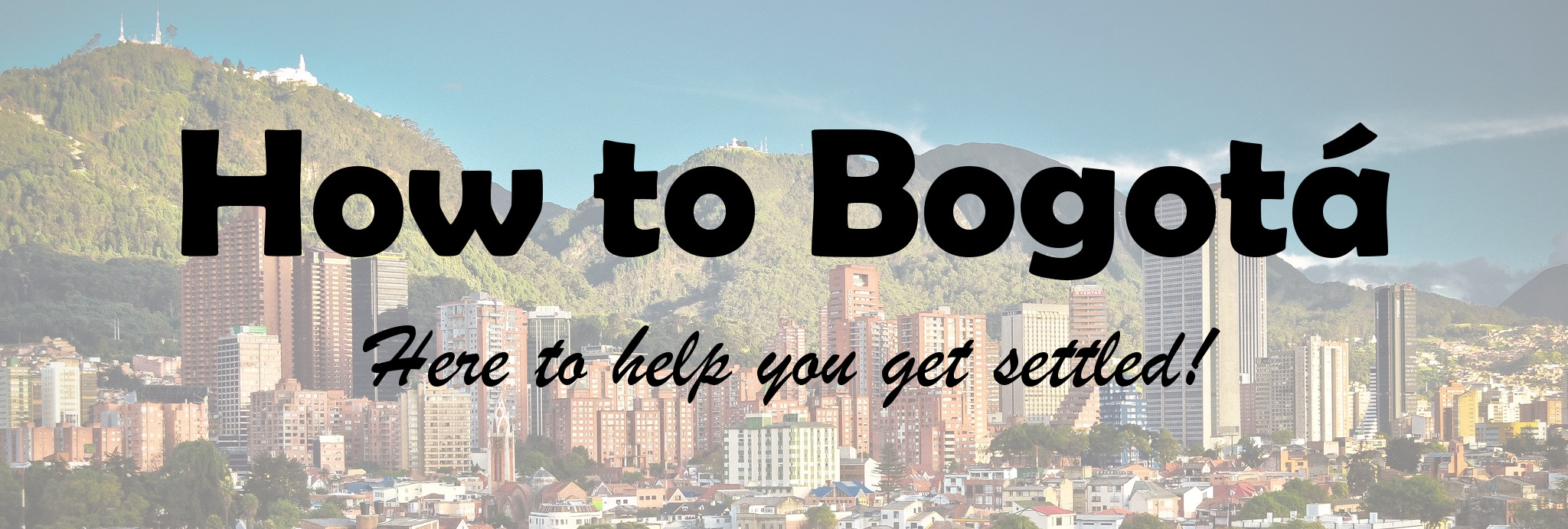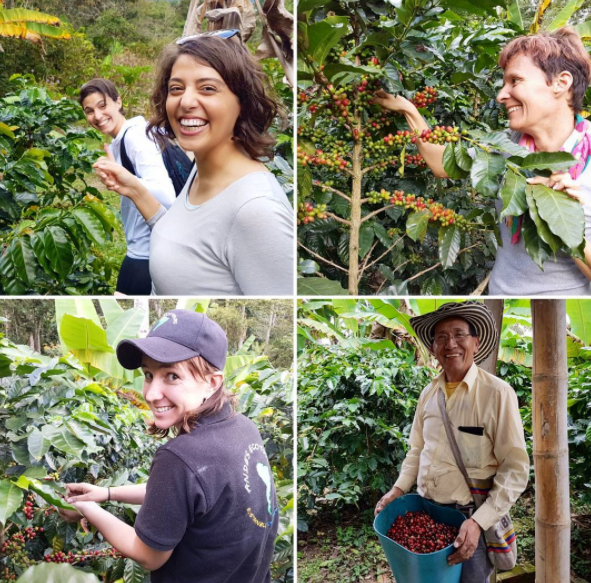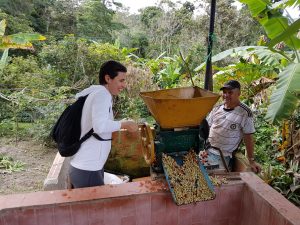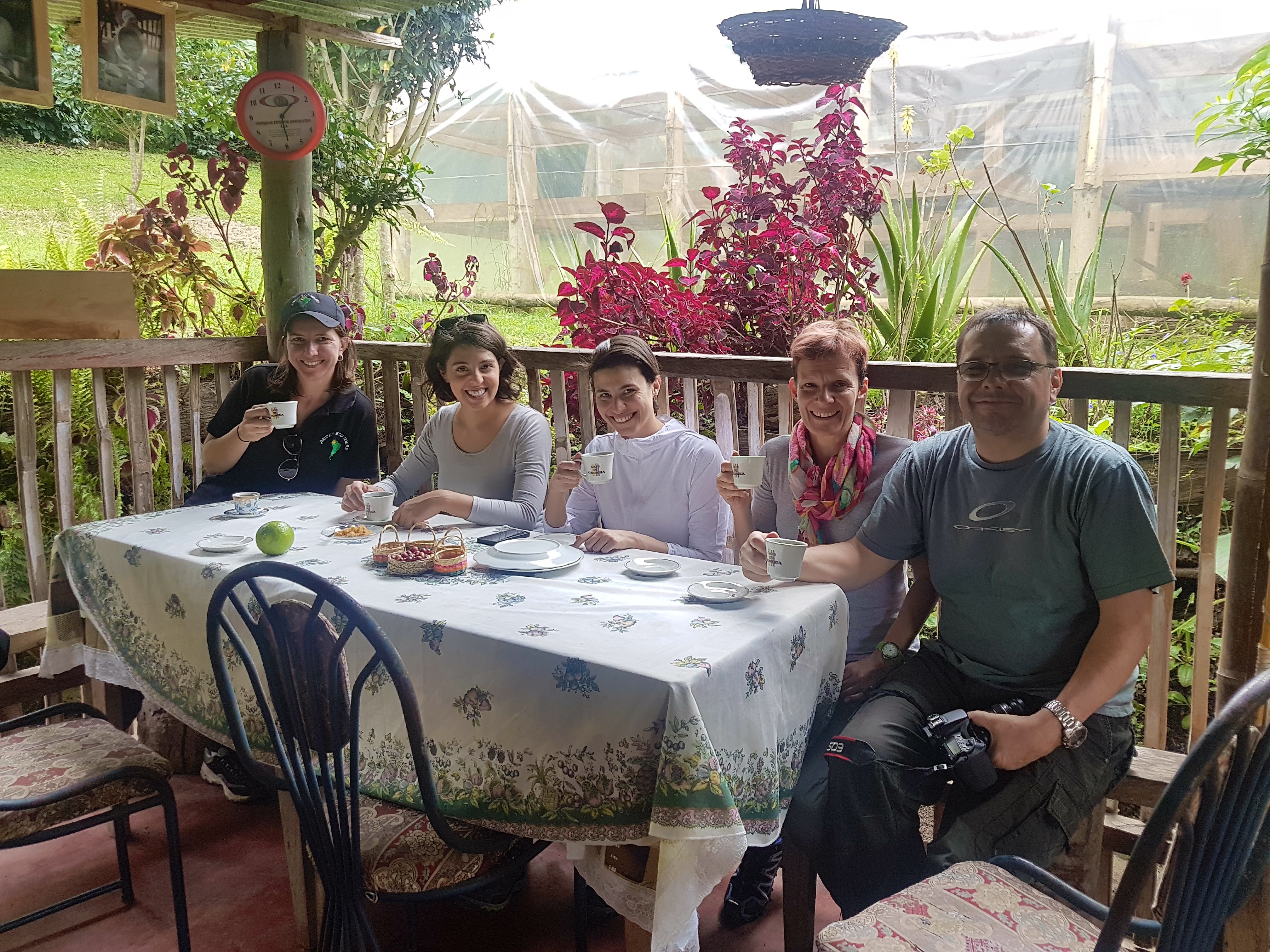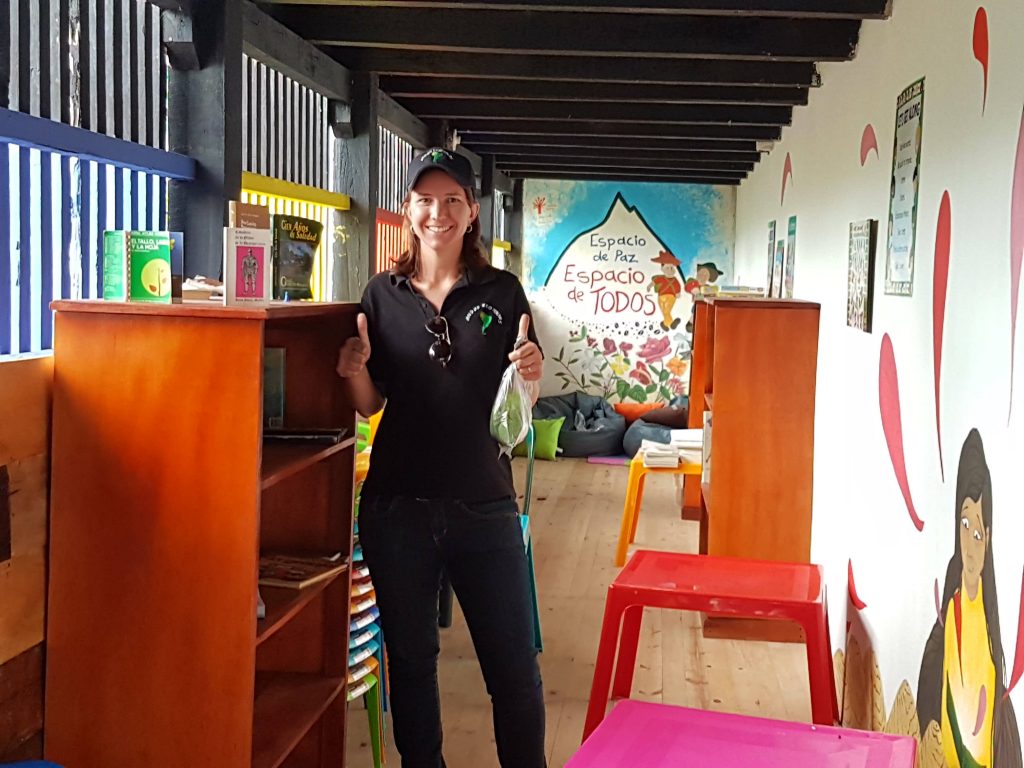Best Colombian coffee farm tour near Bogota [Updated 2024]
As a Brit, I’m not ashamed to admit I’m a proud tea-drinker. But I’m also a huge fan of premium Colombian Arabica coffee (this one from Amor Perfecto is my personal favourite!)
And it goes without saying–there’s nothing like farm fresh Colombian coffee! So when Chantelle from Andes Ecotours invited me to join her on their coffee farm tour near Bogota I jumped at the chance! I first went on this tour in 2013, but it has changed a lot since then, so I had to write about it!
September 2024 update: The tour is still running and continues to be popular!
If you find this blog helpful and would like to say thank you, you can now buy me a digital cup of premium Colombian coffee!
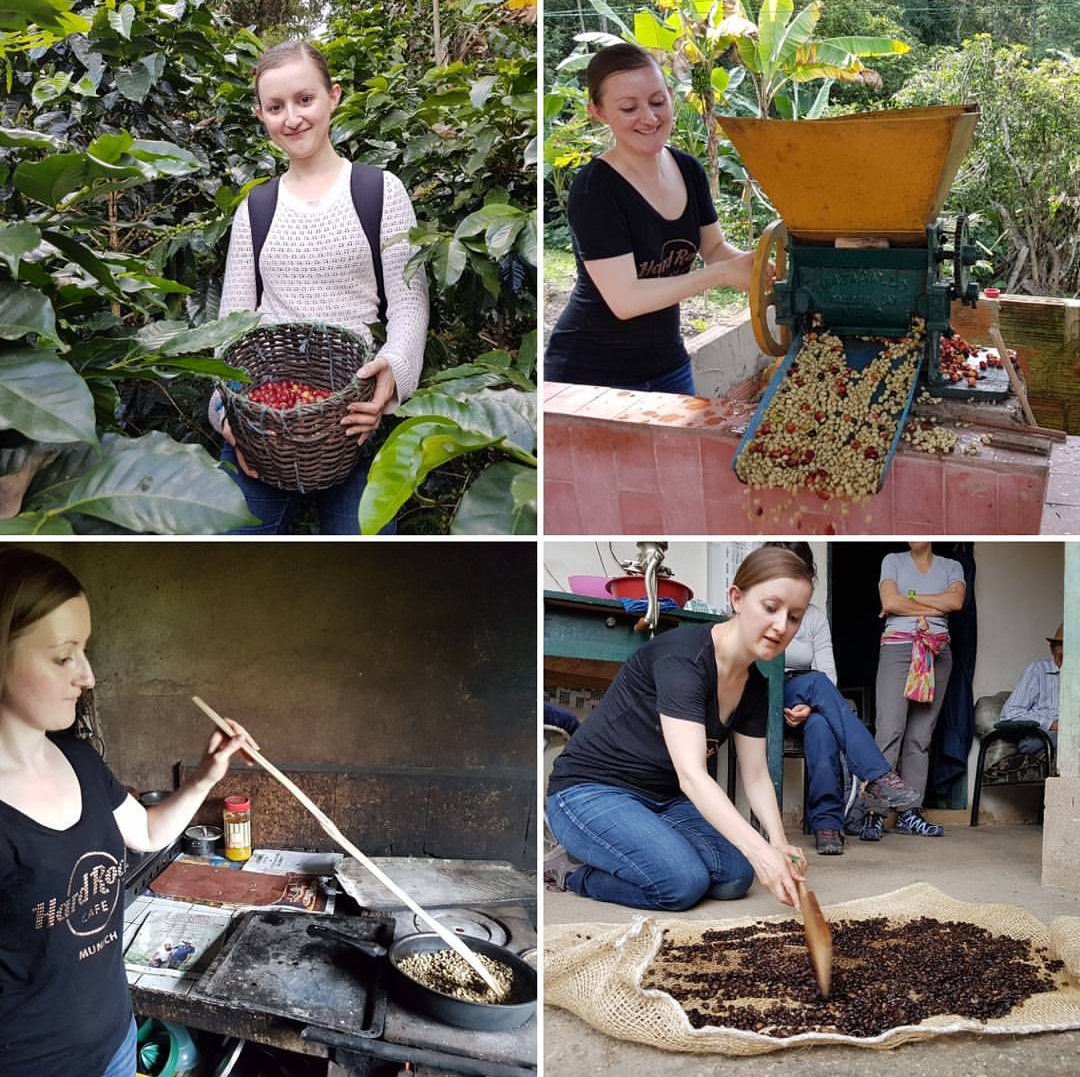
Me, getting my hands dirty on the tour in 2017!
A brief summary
In case you’re just browsing the blog and don’t have time to read this feature-length post, I thought I’d give a quick summary of the best bits of this coffee farm tour near Bogota (scroll down to see the photos!).
This is a hands-on Colombian coffee farm tour which you can do in a day if you’re staying in Bogota. The farms are small family-run farms, not large industrial coffee farms that some other tours visit.
This tour completely immerses you in the coffee-farming and production process. You’ll also learn more about the environment and the land where the coffee beans are produced.
We met the local farmers and their families and they guided us through their land, explaining the names of the different plants and their uses, the birds, the trees, the flowers and the fruits. Some of the highlights for me included spotting a wild tarantula and a baby pineapple plant!
The farmers showed us how to pick the best coffee cherries and then handed over to us! We spent about 15-20 minutes picking ripe coffee cherries, which was fun.
We saw the modern machinery that some farmers use in the coffee production process. We also saw some more traditional, manual production methods.
We also sat down to drink some delicious coffee–including some that we’d roasted and ground ourselves–from scratch. From the plant to the cup!
This tour is a truly immersive and educational experience, and so much fun too! (as you can see from the photos!).
Andes Ecotours works with the local communities and ensures that they benefit directly from ecotourism. The tours offer a form of sustainable development for rural communities and Chantelle and Andrés have done some amazing work with their tour company and the communities.
Transport to and from the coffee farms is included, and the guides that accompany you on the tours speak fluent Spanish and English.
Now for the long version…!
The car journey out of Bogota
We were headed for the Cerro de Quininí near Tibacuy, about two and a half hours’ drive from the center of Bogota. We set off from Chapinero at 8.30am and headed south in the jeep. There were four other people doing the tour, and two of them had actually heard about the tour from this blog! How cool is that?!
During the car journey through Bogota, Chantelle was pointing out different places of interest in the city and explaining the differences between the wealthier north and working-class south of the city. Then we all talked about the cultural differences between our own countries.
Wherever you go in the world, there will always be a ‘safe’ topic of conversation that most people will turn to when making small-talk. In England, it’s usually the weather. In Bogota, it’s the traffic, which is heavy at most times of day and practically stationary during rush-hour! After chatting to the Swiss couple and the two Lebanese girls, I learned that the traffic in Beirut is pretty much comparable to the traffic in Bogota, and that the Swiss love to talk about the outdoors, including fresh air, mountains and hiking! This tour was clearly going to be perfect for them!
First stop in Silvania
Before we got to Tibacuy, we made a stop in a typical little Colombian town called Silvania. There we visited a coffee workshop where the dried unroasted beans are delivered from the farms, packed up, sold and distributed throughout the region. We took a few photos and sat down for a quick breakfast of fruit salad and fresh juice.
Colombia’s Ecosystems
Colombia is home to many different ecosystems due to its varying topography, starting at sea-level on the coast all the way up to 5,700m (18,700ft) in the Sierra Nevada de Santa Marta in the north of the country. Bogota lies at 2,600m (8,600ft). As we continued our journey to the coffee farms in Tibacuy (at 1,650m/5,400ft), Chantelle explained that we were driving through the cloud-forest ecosystem and heading down to the subtropical forest ecosystem, which is host to the coffee lands in Colombia.
The approach to Tibacuy
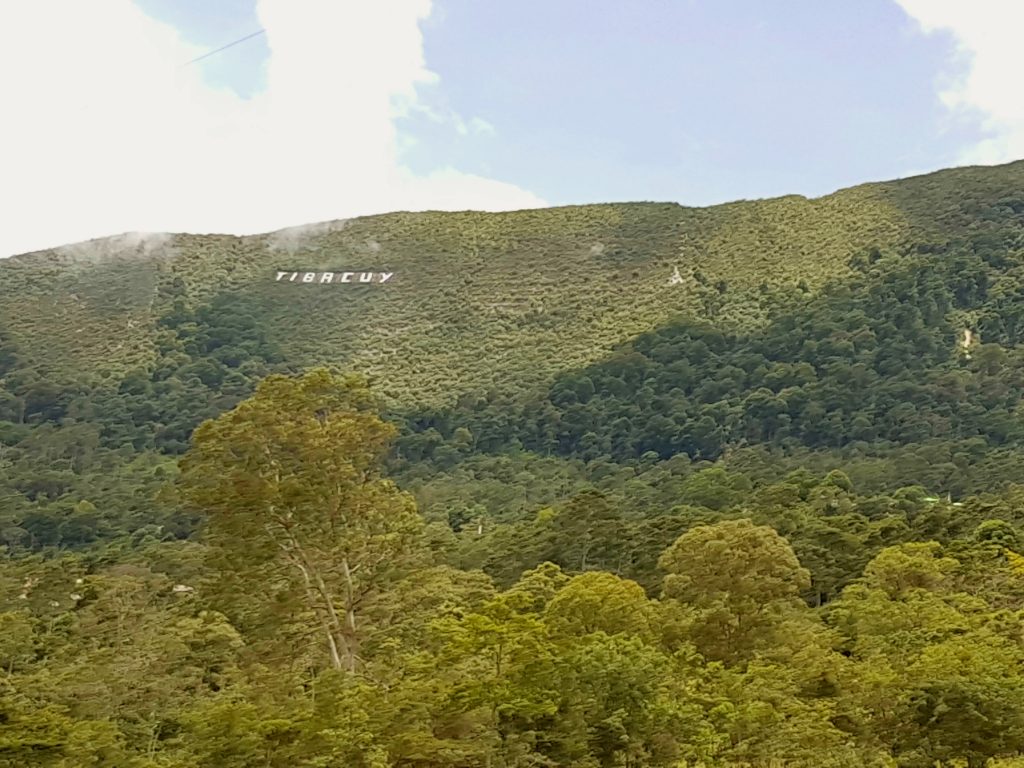 The coffee farms near Bogota are located off the beaten path, so traveling in a jeep is the best option! It’s a little bumpy, so if you suffer from travel sickness, bring along some sweets to suck on or take your usual preventative medication.
The coffee farms near Bogota are located off the beaten path, so traveling in a jeep is the best option! It’s a little bumpy, so if you suffer from travel sickness, bring along some sweets to suck on or take your usual preventative medication.
As we were driving through the hills on our approach to Tibucuy, I spotted a cloud of white suspended in the middle of a field. I asked Chantelle what it was and she said it was a tree inhabited by dozens of white birds called egrets. Chantelle is an expert on Colombian wildlife and leads a number of birdwatching tours in Colombia. I was stunned and vowed that my next adventure with Andes Ecotours would have to involve birdwatching! (Update: as it happened, I did go with Chantelle to the Hummingbird Observatory at a later date. Highly recommended for birders and wildlife photographers!)
Arriving at the coffee farm
This tour includes visits to several small, independently-run family coffee farms in the region, all within walking distance of one another. At the first farm, we were greeted by one of the farm’s owners. She showed us around her garden and told us the names of the different plants, fruits and flowers in her garden, and their uses in cooking and treating ailments. As I had been suffering from ‘Bogota-belly’ for a week or so, she suggested that I should try consuming some raw aloe vera.
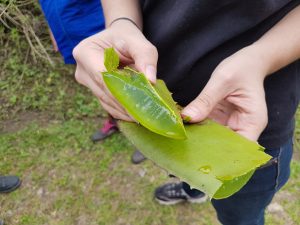 She pulled a leaf from an aloe vera plant, pulled it in two and showed me the colorless gel inside the leaf. “Just take a chunk and eat it, and you’ll feel better,” she said. I did as I was told, thinking that aloe vera must be harmless enough. Don’t they even have aloe vera flavored soft drinks nowadays? As I was swallowing it, Chantelle said, “You might find it a little bitter…”
She pulled a leaf from an aloe vera plant, pulled it in two and showed me the colorless gel inside the leaf. “Just take a chunk and eat it, and you’ll feel better,” she said. I did as I was told, thinking that aloe vera must be harmless enough. Don’t they even have aloe vera flavored soft drinks nowadays? As I was swallowing it, Chantelle said, “You might find it a little bitter…”
A LITTLE?! Within an instant I was begging the rest of the group for ANYTHING which might take away the taste!! One of the girls from Lebanon, Joanna, came to my rescue with some extra strong mints, and luckily a couple of those did the trick! As for my stomach, well, the aloe vera did it no harm as far as I could tell, though I’m not sure I noticed a huge difference. An excellent example of “a spoonful of sugar to help the medicine go down”!
After the tour of the garden, we were shown some of the modern machinery used to process the freshly picked coffee berries, leaving just the white seed inside.
Later on, we headed up to another farm where they still use more traditional manually-operated machinery for processing the berries. But first, we took a seat on our hosts’ patio and watched as she used her special method to prepare us all a delicious cup of coffee. She also served us some tasty snacks, and these definitely helped take the edge off the aloe vera from earlier!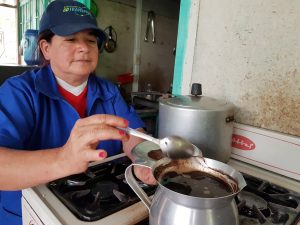
After coffee, we followed Chantelle along a country path to another farmhouse, where we would be having lunch. As we walked, Chantelle pointed out different plants, flowers, and fruits and told us their names and uses.
The temperature was warm and I looked around me. I couldn’t help but shake my head and smile at the lush green mountainous countryside that surrounded us. It’s not every day that you find yourself pushing banana leaves from your path, as you breathe in the smell of fresh mandarins and papayas growing nearby.
The impact of ecotourism on rural communities
We had a delicious and filling home-made vegetarian lunch which cost us just $10,000 pesos (around $3.50 dollars). The money that this family receives for preparing lunches for tourists helps to boost their income and pay for the children’s schooling.
It’s a good example of how community tourism can contribute to sustainable development. Ecotourism gives people in rural communities the incentive to stay and continue working on their farms, without feeling they need to move to the city in order to earn enough money to support their families.
Chantelle and her husband Andrés have dedicated a lot of time and effort over the last few years to building relationships with these communities and helping them to understand how ecotourism can add to their income and make coffee farming an economically viable choice for themselves and for future generations.
Helping with the coffee harvest – a hands-on experience!
The tour continued at a farm down the hill. On the way, Chantelle spotted a wild tarantula at the side of the path. We stopped, took some photos, and admired it from a respectful distance!
At the next farm, the family had a manually operated machine, which functioned in a similar way to the electric-powered one we had seen up the hill. They gave us a demonstration of the machine, kitted us out with baskets, and sent us to gather red-ripe coffee berries. We used these to make our own coffee later on!
Harvesting the coffee was my favorite part of the tour. We were able to experience first-hand what the manual work of a coffee farmer involves, learned how to recognize the ripest berries, and those which had been damaged by parasites or burned by the sun. We were able to explore the different areas of the farm as we picked the berries, working together as a team. I asked one of the farmers if he enjoyed what he did, and he said yes, that it was much nicer and more peaceful than the manual work he used to do in the city.
We took our harvest back and put the berries into the machine which would peel off the fruit, leaving just the white seed inside. Our host took us to up to the farmhouse attic to show us where the beans would be dried.
The beans were then put through a sort of manually-operated grinder, which removed the outer shell of the seed and just left the coffee bean – the part that would later be roasted.
Throughout this whole process we were all able to get involved and experience first-hand the work involved in producing the coffee beans. We took the beans to the stove and roasted them until they had turned a rich dark-chocolate brown color, and then we cooled them and ground them.
We enjoyed another delicious cup of coffee, but this time it was one that we had produced ourselves, from the plant to the cup! There’s nothing like preparing your own cup of coffee from scratch! It was a truly immersive, educational and rewarding experience. I felt it was a privilege to be allowed to interact with and learn first-hand from the local families about their livelihoods. They were warm, friendly and welcoming, and I’m so grateful to them for making this tour possible.
We moved on to another farm where we were able to buy packaged coffee directly from the farmers. I highly recommend buying some, as I’ve never tasted such good coffee!
Chantelle also showed us a library and learning area that Andes Ecotours and volunteers helped to establish for the children in the local area.
The day rounded off with an explosive game of tejo – loads of fun, as you’ll discover if you do this tour!
An immersive, interactive and educational coffee farm tour
I did this coffee farm tour for the first time in 2013, and I really enjoyed it then. Over the last few years, it has developed and become a far more immersive and interactive experience. It was such a wonderful day, and I came away feeling I had a much better understanding of the coffee production process and the lives of independent farmers whose families have run their own coffee farms for generations.
This tour is exceptional, and I can’t recommend it highly enough. If you’re visiting Bogota, this tour is an absolute must!
Thanks to Chantelle from Andes Ecotours for taking me along on this tour.
If you have found this blog informative or entertaining and would like to support How to Bogotá, you can now buy me a digital cup of coffee!
